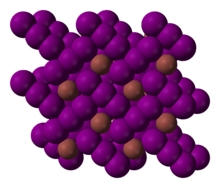Thallium triiodide
Thallium triiodide is a chemical compound of thallium and iodine with formula TlI3. Unlike the other thallium trihalides, which contain thallium(III), TlI3 is a thallium(I) salt and contains the triiodide ion, I3−.
 | |
| Names | |
|---|---|
| IUPAC name
thallium(I) (triiodide) | |
| Other names
thallous triiodide | |
| Identifiers | |
3D model (JSmol) |
|
| |
| |
| Properties | |
| TlI3 | |
| Molar mass | 585.097 g/mol |
| Hazards | |
EU classification (DSD) (outdated) |
|
| NFPA 704 (fire diamond) | |
Except where otherwise noted, data are given for materials in their standard state (at 25 °C [77 °F], 100 kPa). | |
| Infobox references | |
An appreciation as to why Tl+ is not oxidised to Tl3+ in the reaction:
- Tl3+ + 2 I− → Tl+ + I2
can be gained by considering the standard reduction potentials of the half cells which are:
- Tl3+ + 2
e−
→ Tl+; Er° = 1.252 - I2 + 2
e−
→ 2 I−; Er° = 0.5355
The favoured reaction is therefore the reduction of Tl3+ (1.252 > 0.5355).
Using standard electrode potentials in this way must be done with caution as factors such as complex formation and solvation may affect the reaction. TlI3 is no exception as it is possible to stabilise thallium(III) with excess I− forming the TlI4− ion (isoelectronic with the tetraiodomercurate anion and with lead(IV) iodide).
Structure and preparation
TlI3 is formulated Tl+ I3−, and has a similar structure to NH4I3, CsI3 and RbI3.[1] The triiodide ion in TlI3 is nearly linear but is asymmetric with one iodine − iodine bond longer than the other. For comparison the dimensions of the tri-iodide, Ia − Ib − Ic, ions in the different compounds are shown below:
| compound | Ia − Ib (pm) | Ib - Ic (pm) | angle (°) |
|---|---|---|---|
| TlI3 | 306.3 | 282.6 | 177.90 |
| RbI3 | 305.1 | 283.3 | 178.11 |
| CsI3 | 303.8 | 284.2 | 178.00 |
| NH4I3 | 311.4 | 279.7 | 178.55 |
TlI3 can be prepared by the evaporation of stoichiometric quantities of TlI and I2 in concentrated aqueous HI, or by reacting TlI with I2 in ethanol.
References
- WebElements
- Greenwood, Norman N.; Earnshaw, Alan (1997). Chemistry of the Elements (2nd ed.). Butterworth-Heinemann. ISBN 978-0-08-037941-8.
- Die Kristallstrukturen von Rubidiumtriiodid und Thalliumtriiodid Tebbe K.F., Georgy U Acta Crystallographica,C (1986) 42, 1675 doi:10.1107/S0108270186090972
